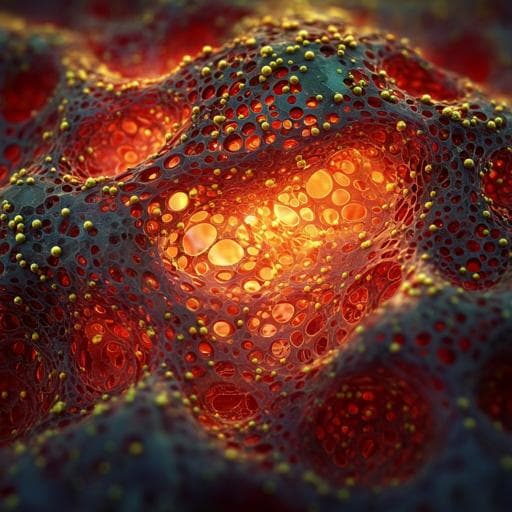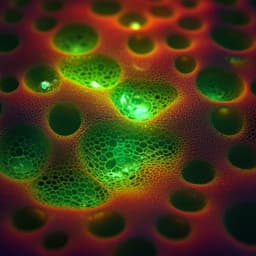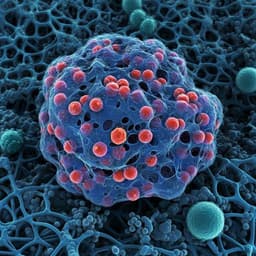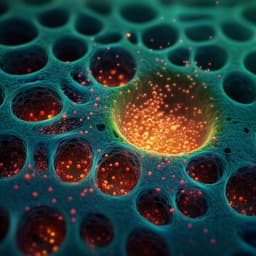
Chemistry
Porous organic polycarbene nanotrap for efficient and selective gold stripping from electronic waste
X. Li, Y. Wang, et al.
Discover the groundbreaking research conducted by Xinghao Li, Yong-Lei Wang, and their team on a novel porous organic polycarbene adsorbent, achieving an astounding gold recovery capacity of 2.09 g/g with 99.8% efficiency from electronic waste solutions. This work paves the way for more sustainable precious metal recovery methods.
~3 min • Beginner • English
Introduction
The study addresses the challenge of efficient and selective recovery of gold from electronic waste, motivated by gold’s high value, extensive use, limited natural supply, and environmental drawbacks of traditional pyrometallurgy. Hydrometallurgy and biometallurgy enable leaching of gold from e-waste, but selective capture from complex ion mixtures remains difficult. Porous organic polymers (COFs, PIMs, PAFs, CMPs) have shown promise but often require tedious syntheses or costly precursors. The authors hypothesize that integrating N-heterocyclic carbene (NHC) chemistry into a porous organic polycarbene (POPcarbene) network can provide strong metal–carbene binding and electron-donating capability to selectively capture and reduce Au ions under ambient conditions, enabling high-capacity, high-selectivity gold recovery, including from complex, realistic e-waste leachates and at trace (ppb) concentrations.
Literature Review
The paper reviews adsorption-based gold recovery materials as environmentally benign alternatives to solvent extraction and electrochemical methods. Examples include: amide-linked COFs with ultrafast Au3+ uptake (equilibrium in ~10 s); porphyrin-phenazine polymers achieving 99% uptake in 30 min and capacities up to 1.62 g/g with redox activity; and hypercrosslinked, polyamine-functionalized POPs with high capacities (~1027 mg/g) under light. Despite performance, these systems often rely on complex synthesis and costly precursors. The authors highlight emerging applications of N-heterocyclic carbenes (NHCs) and polycarbenes in materials science (OLEDs, membranes, actuators), suggesting that combining porosity with carbene chemistry could create effective "nanotraps" for ions, motivating the development of porous polycarbene for gold adsorption.
Methodology
Synthesis and structure: A 1,2,4-triazolium-based poly(ionic liquid), poly[4-cyanomethyl-1-vinyl-1,2,4-triazolium bis(trifluoromethanesulfonyl)imide] (Ptriaz-CN), was synthesized (Mn ~35,739 g/mol; PDI 2.13). Mesoporous adsorbent Ptriaz-CN-A was prepared by dissolving 100 mg Ptriaz-CN in 1 mL EtOH/DMF (17/83 v/v), heating at 80 °C for 4 h, cooling 12 h to induce thermally induced phase separation (TIPS), followed by immersion in 0.5 wt% NH3 in EtOH at room temperature to catalyze nitrile cyclization/crosslinking. Gels were solvent-exchanged with EtOH and dried via supercritical CO2 to yield a porous network. Porosity and morphology: N2 sorption (77 K) gave BET surface area 332 m2/g; NLDFT pore size distribution indicated mesopores (2–32 nm). SEM showed 30–50 nm secondary particles. Surface wettability transitioned to superhydrophilic upon water contact. Crosslinking evidence: FT-IR and 13C NMR of ammonia-treated monomer indicated s-triazine and amidine formation; in the polymer, s-triazine signals dominated. XPS N 1s peaks identified triazolium N sites and crosslinking units, estimating crosslinking degrees ~31.1% (s-triazine) and ~6.8% (amidine). Adsorption experiments: Batch isotherms for Au3+ and Pt2+ (100–5000 ppm) were measured by stirring 24 h to equilibrium, filtering, and quantifying residual metals by ICP-OES. Langmuir and Freundlich models were fitted. Kinetics were tested at pH 2, 4, 7, 9 using 5 mg adsorbent in 10 mL Au3+ (100 ppm), sampling over time. Comparative materials: Imidazolium- and pyridinium-based analogues (Pimidaz-CN-A and Ppyridi-CN-A) were synthesized similarly and evaluated for Au3+ isotherms (100–900 ppm). Selectivity tests: Simulated e-waste solutions contained Co2+, Zn2+, Cu2+, Ni2+, Mg2+, Cr2+ at 300 ppm each, and Au3+ and Pt2+ at 5 ppm. Adsorption used 5 mg adsorbent in 10 mL mixed solution for 6 h, then ICP-OES. Distribution coefficients (Kd) and selectivity coefficients were computed. Trace enrichment: 5 mg Ptriaz-CN-A in 50 mL of 100 ppb Au3+ was stirred at 300 rpm up to 48 h to measure removal. Real e-waste leachate: Disused CPU pins were leached using N-bromosuccinimide/pyridine (neutral pH) at room temperature for 4 days; the filtrate was acidified to pH 2 with HCl. Metal concentrations (Table S4) included Cu2+ (major), Au3+ (minor). Adsorption performance and post-recovery gold characterization were evaluated, including calcination of Au-loaded adsorbent at 900 °C in air, HCl washing, and XRD/EM analyses. Regeneration/reuse: Au-loaded adsorbent (saturated from 100 ppm Au solution) was desorbed using a 1:1 v/v mixture of thiourea (1.0 M) and HCl (1.0 M) at 60 °C for 8 h; adsorption–desorption cycles were repeated 11 times; recovery efficiency (REE) and elution efficiency (EEE) were measured. Mechanism studies: XRD, TEM/SEM/STEM with EDS mapping, XPS (wide scan; high-resolution Au 4f and C 1s), 1H and 13C NMR on Ptriaz-CN and metal complexes to probe metal–carbene interactions and redox states. Computational simulations: DFT (Gaussian 09) modeled adsorption energies (Eads) and binding energies (Ebind) for AuCl4− and PtCl4 2− interacting with a model triazolium unit; stepwise dechlorination with H+ from C5 and formation of metal–carbene bonds were evaluated; HOMO/LUMO, chemical hardness/potential, and electrostatic potentials were analyzed (Multiwfn). Solvent effects were tested; cluster formation (Au0 aggregation) energetics were computed. Sustainability assessment: Streamlined cradle-to-gate LCA (SimaPro 9.0) for 1 g Ptriaz-CN-A at two lab scales (Scale-1 small dose; Scale-2 larger dose), covering ozone depletion, global warming, acidification, eutrophication, carcinogenic/respiratory effects, ecotoxicity, fossil fuel depletion. Cost analysis itemized raw materials and electricity per synthesis step; production costs per gram were calculated for both scales and compared with the value of captured gold.
Key Findings
- High capacity and selectivity: Ptriaz-CN-A achieved an Au3+ uptake capacity of 2.09 g/g, exceeding many reported POPs. Pt2+ capacity was 1.62 g/g (~78% of Au uptake). Langmuir model fit for Au3+ was strong (R2 = 0.988); Pt2+ R2 ~0.88.
- Kinetics and pH: Using 5 mg adsorbent in 10 mL of 100 ppm Au3+, over 90% removal occurred within 30 min at pH 2–7; at pH 9, 76.9% removal in 30 min. In all pH conditions, Au3+ decreased to very low/negligible levels within 12 h.
- Benchmarking: In 100–900 ppm range, Ptriaz-CN-A capacity (1.107 g/g) surpassed Pimidaz-CN-A (0.8225 g/g) and Ppyridi-CN-A (0.8804 g/g).
- Reduction to metallic gold: XRD of Au-loaded Ptriaz-CN-A showed metallic Au peaks; TEM/STEM observed Au nanoparticles of 15–30 nm with elemental Au mapping. Pt- or Cu-loaded samples showed amorphous features without nanoparticles, indicating no analogous reduction.
- Selectivity in complex mixtures: In simulated e-waste containing 300 ppm each of Co2+, Zn2+, Cu2+, Ni2+, Mg2+, Cr2+ and 5 ppm Au3+/Pt2+, Ptriaz-CN-A achieved REE 99.8% for Au3+ (Au down to ~10 ppb) and 98.9% for Pt2+. REEs for others were much lower: Cr2+ 46.1%, Mg2+ 21.5%, Co2+ 1.75%, Cu2+ 4.53%, Ni2+ 18.6%. Kd-based selectivity coefficients favored Au3+ over base metals (e.g., Au3+/Ni2+ ~2.2×10^3; Au3+/Cu2+ ~1.1×10^2).
- Trace capture: From 100 ppb Au3+, 95.2% removal in 24 h and >99.9% in 48 h using 5 mg in 50 mL.
- Real e-waste leachate: CPU pin leachate (NBS/pyridine) contained Cu2+ 357.56 ppm and Au3+ 2.235 ppm. Ptriaz-CN-A achieved REE ~92.75% for Au3+ and ~36.97% for Pt2+; Cu2+ decreased by ~8 ppm to 349.22 ppm (REE 2.33%). Recovered particles were confirmed as metallic Au by XRD and EM after calcination and acid washing.
- Regeneration and reusability: With 1.0 M thiourea/1.0 M HCl (1:1 v/v) eluent at 60 °C for 8 h, REE remained >95% for six adsorption–desorption cycles; REE decreased thereafter due to pore space loss from accumulated Au nanoparticles. After 11 cycles, regenerated adsorbent still exhibited >60% elution efficiency for Au3+.
- Mechanism evidence: XPS Au 4f showed Au0, Au+ and Au3+ states at higher loadings, indicating stepwise reduction during adsorption. C 1s XPS showed a significant C5 binding energy shift (285.23→286.8 eV) upon Au adsorption, implicating C5-carbene in binding; negligible C5 shifts for Pt2+ and Cu2+. 1H NMR: disappearance of C5 proton upon Au3+ addition; 13C NMR: C–Au signal at 174 ppm. For Pt2+/Cu2+, only slight C5 proton shifts (H···M interactions), with no carbene–metal signals.
- DFT insights: For PtCl4 2−, Eads = −17.42 eV; although Ebind (Pt–carbene) = −7.08 eV, the overall ΔE for dechlorination and bond formation was positive (thermodynamically unfavorable at room temperature); similar for Cu2+. For AuCl4−, stepwise process showed ΔE1 = 8.16 eV (adsorption), ΔE2 = −10.61 eV (two HCl formation and Au–carbene bond; Ebind = −7.28 eV), ΔE3 = −12.25 eV (further dechlorination to Au0; Ebind with NHC = −4.62 eV), and aggregation ΔE4 = −2.18 eV (Au0 cluster growth), supporting spontaneous adsorption-reduction and nanoparticle formation; solvent inclusion did not change trends.
- Sustainability and cost: Streamlined LCA indicated lower environmental impacts at larger lab scale (Scale-2) across all categories (due to higher equipment utilization). Production cost per gram was ~117.0 CNY (Scale-1) and ~107.3 CNY (Scale-2), >95% from raw materials. The estimated value of gold captured by 1 g adsorbent is ~795.2 CNY (gold price ~380.5 CNY/g), with additional gains from recyclability, indicating favorable economics upon scale-up.
Discussion
The findings demonstrate that incorporating 1,2,4-triazolium-derived carbene sites into a porous organic network creates highly active, selective adsorption centers for Au3+ that both bind strongly via metal–carbene bonds and donate electrons to reduce Au3+ to Au0, culminating in nanoparticle formation confined within mesopores. This dual binding–reduction mechanism explains superior selectivity for Au over base metals and even over Pt under the tested conditions, as corroborated by XPS, NMR, and DFT thermodynamics. The mesoporous architecture (332 m2/g, 2–32 nm pores) ensures access to abundant active sites and facilitates aggregation of reduced Au into 15–30 nm particles without compromising early-cycle performance. Performance in realistic CPU leachates (neutral NBS/pyridine leaching) confirms practical utility under benign conditions, achieving high Au recovery despite overwhelming Cu presence. The ability to concentrate Au from ppb levels highlights sensitivity for dilute streams. Despite some capacity fade with repeated use due to pore occupation by Au nanoparticles, recycling with thiourea/HCl maintains high efficiency over multiple cycles. LCA and cost analysis suggest environmental and economic viability improves with scale, supporting prospects for industrial deployment. Overall, the work validates carbene chemistry as a powerful strategy for precious metal recovery materials, particularly for selective urban mining of gold from complex e-waste matrices.
Conclusion
A porous organic polycarbene (Ptriaz-CN-A) was developed that exhibits ultrahigh Au3+ adsorption capacity (2.09 g/g), exceptional selectivity (up to 99.8% recovery in complex mixtures), and intrinsic redox capability to reduce Au3+ to Au0, forming stabilized nanoparticles within a mesoporous network. Spectroscopic analyses (XPS, NMR) and DFT calculations collectively establish a metal–carbene binding and spontaneous reduction mechanism specific to Au, explaining the superior selectivity versus Pt and base metals. The adsorbent performs effectively in authentic e-waste leachates and can be regenerated repeatedly, while streamlined LCA and cost analysis indicate favorable environmental and economic potential, especially upon scale-up. Future work could focus on optimizing pore architecture to mitigate capacity loss from nanoparticle accumulation, extending carbene-based adsorbents to other precious metals or mixed-metal separations, integrating continuous-flow processes, and scaling synthesis with greener solvents and lower-cost precursors.
Limitations
- Reusability constraints: Recovery efficiency declines after six cycles due to gradual occupation of pore space by accumulated Au nanoparticles, which reduces available adsorption sites.
- Selectivity nuances: While Au selectivity is outstanding, moderate uptake of certain interferents (e.g., Cr2+ REE ~46.1% in simulated mixtures) indicates potential competitive adsorption depending on matrix composition; Pt is captured but to a lesser extent than Au in real leachates.
- Cost and scale: Laboratory-scale production costs are relatively high (≥107 CNY/g), though analyses suggest significant reductions at larger scale; current LCA is lab-scale and may not reflect full industrial scenarios.
- Leachate specificity: Performance was validated with NBS/pyridine neutral leaching and specific CPU-derived matrices; broader variability in e-waste streams and alternative leachants may impact performance and require further validation.
Related Publications
Explore these studies to deepen your understanding of the subject.







